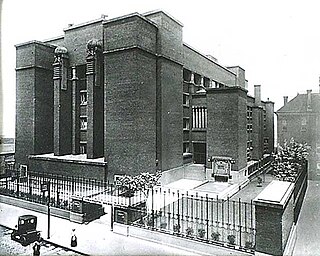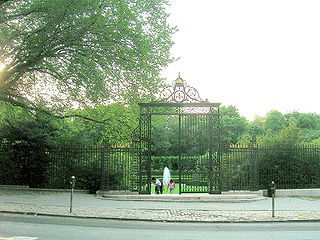
The Museum of the City of New York (MCNY) is a history and art museum in Manhattan, New York City, New York. It was founded by Henry Collins Brown, in 1923 to preserve and present the history of New York City, and its people. It is located at 1220–1227 Fifth Avenue between East 103rd to 104th Streets, across from Central Park on Manhattan's Upper East Side, at the northern end of the Museum Mile section of Fifth Avenue.

The Central Park Zoo is a 6.5-acre (2.6 ha) zoo located at the southeast corner of Central Park in New York City. It is part of an integrated system of four zoos and one aquarium managed by the Wildlife Conservation Society (WCS). In conjunction with the Central Park Zoo's operations, the WCS offers children's educational programs, is engaged in restoration of endangered species populations, and reaches out to the local community through volunteer programs.

The Prospect Park Zoo is a 12-acre (4.9 ha) zoo located off Flatbush Avenue on the eastern side of Prospect Park, Brooklyn, New York City. As of 2016, the zoo houses 864 animals representing about 176 species, and as of 2007, it averages 300,000 visitors annually. The Prospect Park Zoo is operated by the Wildlife Conservation Society (WCS). In conjunction with the Prospect Park Zoo's operations, the WCS offers children's educational programs, is engaged in restoration of endangered species populations, runs a wildlife theater, and reaches out to the local community through volunteer programs.

Druid Hill Park is a 745-acre (3.01 km2) urban park in northwest Baltimore, Maryland. Its boundaries are marked by Druid Park Drive (north), Swann Drive and Reisterstown Road, and the Jones Falls Expressway / Interstate 83 (east).

The Saalburg is a Roman fort located on the main ridge of the Taunus, northwest of Bad Homburg, Hesse, Germany. It is a cohort fort, part of the Limes Germanicus, the Roman linear border fortification of the German provinces. The Saalburg, located just off the main road roughly halfway between Bad Homburg and Wehrheim is the most completely reconstructed Roman fort in Germany. Since 2005, as part of the Upper German limes, it forms part of a UNESCO World Heritage site. In the modern numbering system for the limes, it is ORL 11.

The Larkin Building was an office building in Buffalo, New York, noted for innovations that included central air conditioning, built-in desk furniture, and suspended toilet partitions and bowls. Located at 680 Seneca Street, it was demolished in 1950.

The Conservatory Garden is a formal garden near the northeastern corner of Central Park in Upper Manhattan, New York City. Comprising 6 acres (24,000 m2), it is the only formal garden in Central Park. Conservatory Garden takes its name from a conservatory that stood on the site from 1898 to 1935. It is located just west of Fifth Avenue, opposite 104th to 106th Streets.

Martin Euclid Thompson (1786–1877) was an American architect and artist prolific in nineteenth-century New York City, and a co-founder of the National Academy of Design.

Roosevelt Hall (1903–1907) is an immense Beaux Arts-style building housing the National War College on Fort Lesley J. McNair, Washington, DC, USA. The original home of the Army War College (1907–1946), it is now designated a National Historical Landmark (1972) and listed on the National Register of Historic Places (1972).

810 Fifth Avenue is a luxury residential housing cooperative on the Upper East Side of Manhattan, New York City.

1040 Fifth Avenue is a luxury residential housing cooperative in the Upper East Side of Manhattan, New York City.

Rockland County Courthouse and Dutch Gardens is a historic county courthouse, public garden, and national historic district located at New City in Rockland County, New York. The district has two contributing buildings, one contributing site, five contributing structures, and two contributing objects.
St. John Chrysostom's Church is a Roman Catholic parish church under the authority of the Roman Catholic Archdiocese of New York, in the Morrisania section of the New York City borough of the Bronx.
Bettendorf–Washington School, also known as the Bettendorf Park Board Fine Arts Annex, was a historic building located in Bettendorf, Iowa, United States. It was listed on the National Register of Historic Places in 1984.

The 14th Regiment Armory, also known as the Eighth Avenue Armory and the Park Slope Armory, is a historic National Guard armory building located on Eighth Avenue between 14th and 15th Streets in the South Slope neighborhood of Brooklyn, New York City, United States. The building is a brick and stone castle-like structure, and designed to be reminiscent of medieval military structures in Europe. It was built in 1891–95 and was designed in the Late Victorian style by William A. Mundell.

Riverside is a neighborhood in Wichita, Kansas, United States. A mostly residential area located between the Arkansas and Little Arkansas Rivers, it is home to several of the city's museums and large parks.

The Acworth Silsby Library is the public library of Acworth, New Hampshire, located in the town center at 5 Lynn Hill Road. Built in 1891 and funded by Acworth native Ithiel Homer Silsby, the building is a distinctive local example of Romanesque architecture. The building was listed on the National Register of Historic Places in 1983.

The Caspar Samler farm was a tract of land comprising the greater part of Fifth Avenue from Madison Square to 31st Street in what is now the Koreatown section of Manhattan, New York City, New York.

Allen Russell Saalburg (1899–1987) was an American painter, illustrator, and screen printer born in Rochelle, Illinois. His father was the cartoonist Charles W. Saalburg. He studied at the Art Students League of New York before working in advertising and magazine illustration in the 1920s. A business trip he took to Paris in 1929 with his wife, sketching runway fashion for department stores, led to his first gallery show, at the esteemed Bernheim-Jeune, with his second in New York at a gallery of Louis Bouché. During the 1930s he had regular shows of screenprints on glass and wall panels, and directed a mural division of the Works Progress Administration (WPA), in New York City, overseeing murals in the Central Park Zoo and other New York locations. His murals in the Arsenal of Central Park survive today.

The University of Michigan Central Campus Historic District is a historic district consisting of a group of major buildings on the campus of the University of Michigan in Ann Arbor, Michigan. It was listed on the National Register of Historic Places in 1978.




















